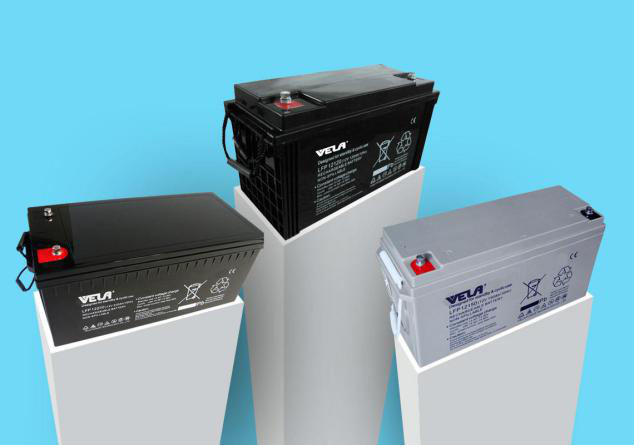
1.Solar batteries are widely used in our life.
Solar batteries are the application of battery in solar photovoltaic power generation.Currently,there are four types of lead-acid batteries including maintenance-free batteries ,ordinary lead-acid batteries, gel batteries and alkaline nickel-cadmium batteries. The widely used solar batteries are mainly: lead-acid maintenance-free batteries and gel batteries, these two types of batteries, because of their inherent “free” maintenance characteristics and less environmental pollution,they are very suitable for reliable solar power supplies system, especially unattended workstations.Our company VELA POWER, we have produced and selled these two kinds of batteries for more than 15 years. and they have been exported to many countries.Our main customers include North America,Latin and South America,Middle East,Africa,Europe ect in all over the world.Customer satisfaction with our products is 100%.
2.Some types of battery being used in solar system.
2.1. Open type fixed lead storage battery
Open-type fixed lead storage battery is mainly used for communication power supply, power plant and substation switch closing, accident power, backup power supply and other fixed places. It has the characteristics of large capacity and relatively long life. Compared with starting batteries (lead batteries for automobile starting, which are not suitable for use in photovoltaic power generation systems), the performance of fixed batteries is closer to the requirements of photovoltaic systems. Therefore, currently most open fixed types Lead-acid batteries are applied in photovoltaic systems .
2.2 Sealed lead battery
In the 1980s, sealed lead storage batteries were begin to use, only a few production lines for sealed lead storage batteries were working at that time.Since then, sealed lead storage batteries are also used in photovoltaic power generation systems. Sealed lead-acid batteries are easy to maintain and transport, but the price is more expensive, generally 2 to 3 times of the open typed lead batteries. Sealed lead batteries are prone to damage due to overcharging in high temperature climatic conditions.
2.3. Maintenance-free lead-acid batteries
At present, many mobile devices on the market is fully sealed and maintenance-free lead-acid batteries. This type of battery has been used successfully for many years. The electrolyte sulfuric acid is fixed by silicone gel or absorbed by glass fiber separators. The electrolyte cannot flow in the battery cell, avoiding the leakage of the electrolyte. The maintenance-free lead-acid battery successfully solves the problem of poor weather resistance faced by VRLA lead-acid batteries in all-weather work in a natural environment.
2.4. Gel battery
Gel battery is a branch of valve-regulated lead-acid battery(VRLA). Its electrolyte is composed of sulfuric acid, silica gel, deionized water and phosphoric acid additives. It is in the form of thixotropic gel; even if the battery is tilted or punctured, the electrolyte will not flow out. In theory, it can be placed arbitrarily. Compared with lean-liquid valve-regulated lead-acid batteries, deep discharge and accidental overcharge can be tolerated. Because of its non-leakage, complete maintenance-free and extremely low self-discharge rate, it is especially suitable for use as a backup power supply in communications and other fields. In recent years, it is generally believed that valve-controlled batteries using silica gel technology will be the inevitable trend of power development.
2.5.Alkaline battery
Alkaline batteries can be divided into nickel-cadmium batteries and nickel-iron batteries according to their plate materials. Compared with lead batteries, alkaline batteries have the advantages of small size, deep discharge, resistance to overcharge and overdischarge, long service life and simple maintenance. The main disadvantages of alkaline batteries are large internal resistance, low electromotive force, and high cost (about 4 to 5 times that of lead batteries)Since the performance-price ratio of lead-acid batteries is better than that cadmium-nickel batteries, lead-acid batteries still have certain advantages in photovoltaic systems.

3.How to choose solar battery ?
When selecting batteries, it is very necessary to know the differences between the processes and the use of various batteries.
Firstly, we must fully know the needs of the users themselves. For example, the capacity requirements of the backup power system, the frequency of use, the environment of use, the main purpose, the service life, the reliability requirements, the instantaneous discharge rate, the specifications of the rectifier, and other battery-related performance requirements.
Secondly, we must know the electrical performance of the battery, including product design parameters (battery model, appearance size, rated capacity, rated voltage, weight, weight ratio energy, volume ratio energy, design life, number of positive and negative plates, positive and negative plates Thickness ratio, electrolyte density, plate type, grid material, etc.), product electrical performance parameters, product actual service life, installation and use environment, performance and price of different models, and warranty periods for different types of products.



